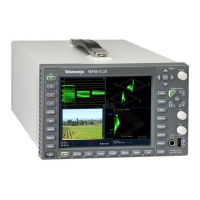Video and General Performance Verification Procedures
5. Using the grati
cule, check that the waveform is 600 mV ±80 mV.
6. Record Pass or Fail in the test record.
SD Jitter Nois
eFloor
(Options EYE and PHY)
This test checks the jitter noise floor of the waveform monitor. Since some jitter
may be introduced by the signal source, you may need to characterize the TG2000
output jitte
r with an oscilloscope. Most DVG1 generators have an output noise
floor in the 200 ps range.
1. Set the wave
form monitor to t he factory presets. (See page 60, Restore the
Factory Presets.)
2. Connect th
e TG2000 DVG1 upper (Clean) output to the SDI A input on the
waveform monitor.
3. Select th
e 525 75% color bar signal from the DVG1.
4. Press the Input A button.
5. Press the Display Select button for the WFM display and press FULL to set
the WFM tile to full screen.
6. Set the waveform monitor to the jitter display:
a. Press the EYE button to view the Eye d isplay.
b. Press and hold the EYE button to display the menu.
c. Select Display Type and then Jitter Display.
7. Set t
he jitter high pass filter to 100 Hz:
a. Select Jitter1 HP Filter from the Eye menu.
b. Select 100 Hz.
8. Set the vertical gain to x10:
a. Press and hold the GAIN button.
b. Select Gain Settings and then select x10.
9
.
V
erify that the jitter trace is displayed and stable.
10. Using the graticule or t he cursors, measure the jitter amplitude.
11. Check that the jitter amplitude is approximately 250 ps (0.068 UI), depending
on the TG2000 output jitter.
12. Record Pass or Fail in the test record.
108 Waveform Monitors Specifications and Performance Verifi cation

